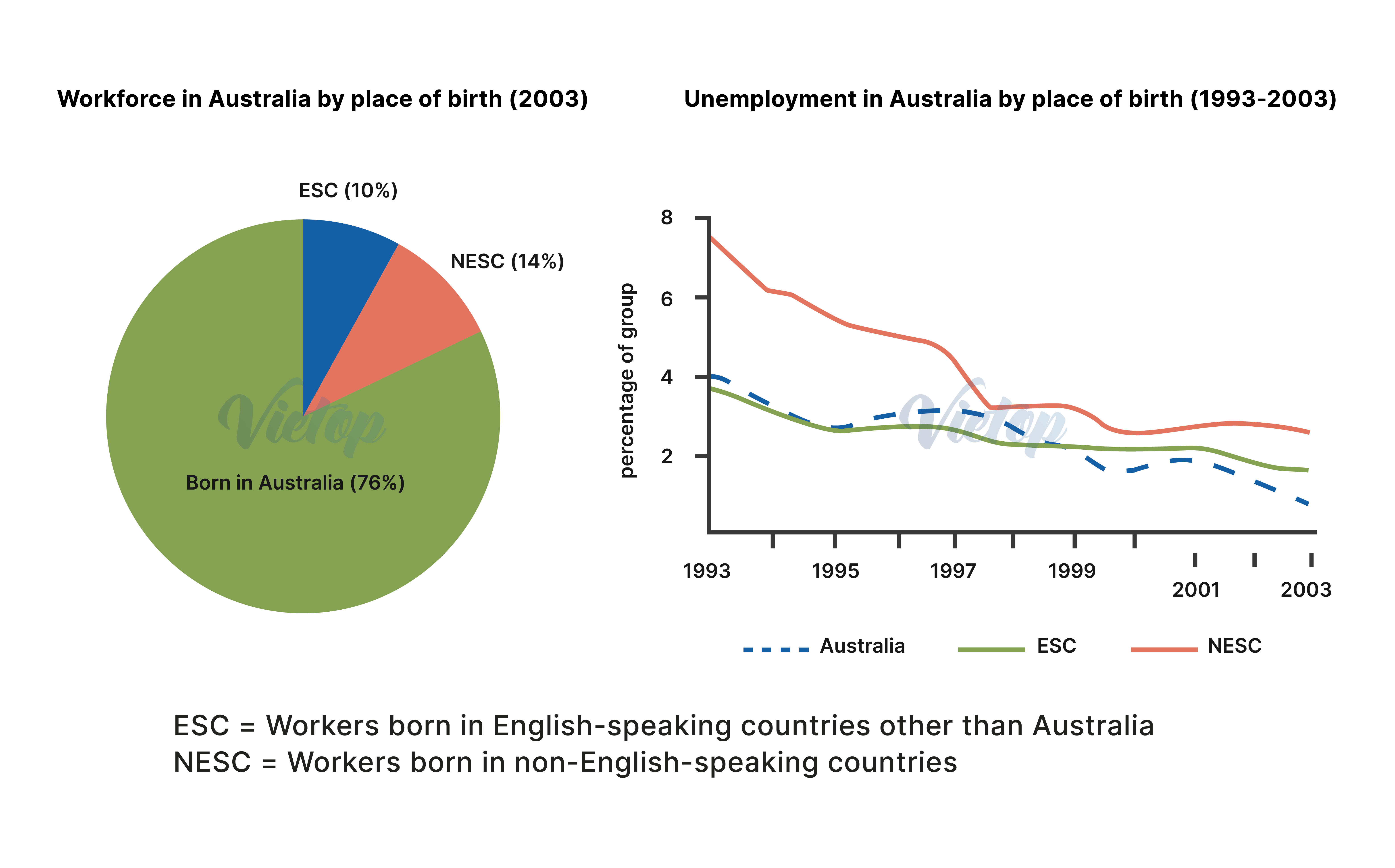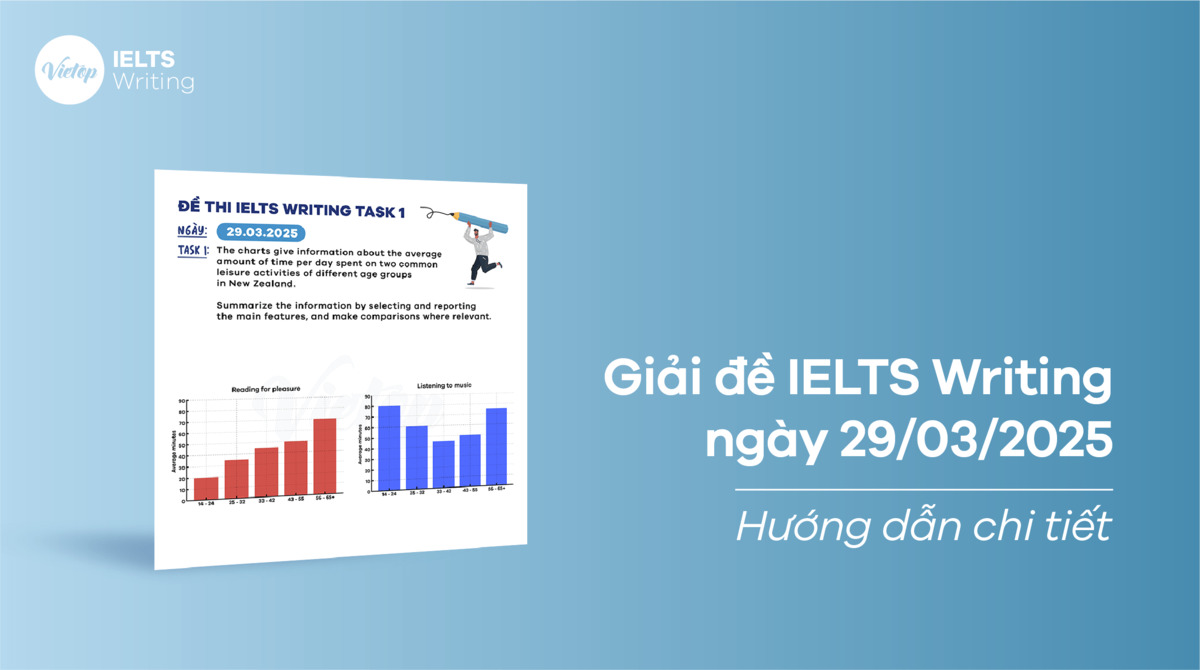Trong bài viết sau, thầy/ cô sẽ gửi đến bạn cách giải đề IELTS Writing ngày 17/02/2024 chi tiết qua:
- Lập dàn ý và phân tích bảng.
- Các bài mẫu cho từng band điểm.
- Tổng hợp từ vựng và cấu trúc quan trọng.
Cùng tham khảo ngay để luyện tập thêm thật kỹ bạn nhé!
IELTS Writing task 1
The chart and graph below give information about three categories of workers in Australia and the unemployment levels within those groups.

Bước 1: Lập dàn ý
Đoạn tổng quan: Nhìn chung, người Úc bản địa chiếm đa số lao động tại Úc, và trong khi xu hướng giảm đã được ghi nhận ở tất cả ba danh mục được xem xét, những người lao động đến từ các nước nói tiếng khác, mặc dù ghi nhận sự suy giảm đáng kể nhất, vẫn chiếm ưu thế trên biểu đồ về mặt thất nghiệp suốt suốt thời kỳ.
| Thân bài 1 | Thân bài 2 |
| Về phân phối lực lượng lao động, thị trường lao động Úc bị chi phối bởi những người lao động có nơi sinh là nước Úc, chiếm tỷ lệ đáng kể là 76%. So sánh với đó, có lẽ ít lao động hơn ở hai danh mục còn lại được tuyển dụng tại Úc, với 14% đến từ các nước nói tiếng không phải tiếng Anh có việc làm tại Úc so với chỉ 10% đối với những người lao động sinh ra ở các nước nói tiếng Anh ngoại trừ Úc. | Chuyển sang cách tỷ lệ thất nghiệp của ba loại lao động này thay đổi, tỷ lệ nhân viên từ các nước không sử dụng tiếng Anh làm ngôn ngữ mẹ của họ đạt đỉnh vào năm 1993, chiếm 8%, sau đó giảm đáng kể xuống còn 4% vào khoảng năm 1998. Từ điểm này trở đi, mặc dù có một số biến động nhẹ, con số của họ vẫn tương đối ổn định ở mức khoảng 3% cho đến năm cuối cùng. Sự thay đổi tương tự, nhưng ở mức độ nhỏ hơn, đã được ghi nhận ở người lao động Úc và những người sinh ra ở các nước nói tiếng Anh khác ngoại trừ Úc, tỷ lệ của họ giảm dần từ 4% trong năm đầu tiên trước khi kết thúc giai đoạn ở mức khoảng 2% và 1% tương ứng. |
Bước 2: Hoàn thành bài luận
The pie chart gives a breakdown of employment in Australia divided into three groups of workers in 2003, while the line graph illustrates how the unemployment rate of these types of workers changed from 1993 to 2003.
Overall, native Australians made up the majority of workers in Australia, and while falling trends were recorded in all three categories examined, workers who came from non-English-speaking countries, despite witnessing the most dramatic decline, still dominated the graph in terms of unemployment throughout the period.
Regarding the distribution of workforce, the Australian labor market was dominated by workers whose birthplace was also in that country, accounting for a significant 76%. In comparison, there were noticeably fewer workers in the the remaining two categories who were employed in Australia, with 14% of workers from non-English-speaking countries having a job in Australia compared to a mere 10% among workers born in English-speaking countries except for Australia.
Turning to how unemployment rates of these three types of workers changed, the percentage of employees from countries who did not use English as their mother tongue was at its peak in 1993, making up 8%, after which it saw a substantial decline to 4% around 1998. From this point onwards, despite some mild fluctuations, its figures remained relatively stable at around 3% until the final year. Similar changes, but to lesser extents, were witnessed in Australian workers and those born in other English-speaking countries, whose proportions dropped gradually from 4% in the first year before ending the period at approximately 2% and 1% respectively.
Xem thêm:
- [ACE THE TEST] Giải đề IELTS Writing ngày 27/01/2024
- [ACE THE TEST] Giải đề IELTS Writing ngày 18/01/2024
- [ACE THE TEST] Giải đề IELTS Writing ngày 13/01/2024
Mixed chart là một trong những dạng bài khó ở phần thi IELTS Writing task 1, yêu cầu người học cần có khả năng phân tích và tổng hợp thông tin từ nhiều loại biểu đồ khác nhau. Trong khoá học IELTS 6.0 tại Vietop, bạn sẽ được hướng dẫn chi tiết về cách phân tích đề, chọn lọc thông tin và cách kết hợp số liệu ở dạng bài mixed chart. Qua việc luyện tập với các bài mẫu giải đề IELTS Writing thực tế sẽ giúp bạn tự tin hơn cho kỳ thi IELTS.
IELTS Writing task 2
More people put their personal information online (address, telephone number…) for everyday activities such as socializing on social networks or banking. Do you think it is a positive or negative development?
Bước 1: Phân tích đề
- Từ khoá: Personal information online, socializing on social networks, banking
- Câu hỏi: Đề bài yêu cầu thí sinh đưa ra quan điểm đây là khuynh hướng phát triển tích cực hay tiêu cực. Ở đây Vietop sẽ đi theo hướng có tiêu cực nhiều hơn nhé.
Bước 2: Lập kế hoạch cho bài luận
| Thân bài 1 | Thân bài 2 |
| Topic Sentence: The digitization of personal details offers various advantages. (Việc đưa thông tin lên mạng có nhiều lợi ích.) Supporting Ideas: Socialization and Connection (gắn kết xã hội) – Social media platforms facilitate virtual connections. (Các trang mạng xã hội giúp kết nối con người với nhau.) – Allows individuals to share updates, photos, and engage in discussions. (Giúp mọi người chia sẻ thông tin, hình ảnh, và trao đổi ý tưởng với nhau.) Financial Convenience (lợi ích về kinh tế) – Online disclosure enhances access to various services. (Việc đưa thông tin lên mạng giúp người ta tiếp cận với những loại hình dịch vụ khác nhau.) – Online banking becomes more convenient for financial transactions and account management. (Giao dịch tiền bạc và quản lý tài khoản trở nên dễ dàng hơn khi có ngân hàng online.) | Topic Sentence: The positive aspects are overshadowed by significant drawbacks. (Tác hại của việc đưa thông tin cá nhân lên mạng nhiều hơn lợi ích.) Supporting Ideas: Loss of Privacy (mất quyền riêng tư) – Public disclosure exposes individuals to cybersecurity risks. (Đưa thông tin công khai trên mạng có thể gây nguy hiểm cho người dùng.) – Cybercriminals may exploit sensitive details for malicious purposes. (Tội phạm sẽ lợi dụng khai thác thông tin cá nhân của người dùng cho mục đích xấu.) – Potential consequences include tarnished reputation and emotional distress. (Gây ra hậu quả nặng nề cho danh dự, nhân phẩm và cảm xúc của nạn nhân.) Rise in Identity Theft (bị ăn cắp thông tin) – Sharing information online becomes a breeding ground for identity theft. (Chia sẻ thông tin lên mạng là “miếng mồi ngon” cho kẻ xấu.) – Criminals use stolen information to impersonate individuals. (Kẻ xấu sẽ dùng thông tin để giả danh người dùng.) – Unauthorized access to bank accounts raises concerns about substantial financial losses. (Nhập thông tin vào tài khoản ngân hàng dễ gây thiệt hại về tiền bạc.) |
Bước 3: Hoàn thành bài luận
In the contemporary digital age, with the Internet becoming an omnipresent element of daily life, a significant portion of people’s private information is shared online. This development, despite bringing about certain benefits, is an undesirable one, given its serious impacts on individuals’ privacy, finance and psychological well-being.
On the one hand, the advantages of the digitization of personal details are evident. Firstly, sharing personal information on social networks enables individuals to socialize and maintain connections with friends, family, and acquaintances. Social media platforms offer a platform for users to post updates, photos, and participate in discussions, nurturing virtual connections that may be challenging to establish through conventional methods. From a financial perspective, online disclosure of personal information enables individuals to effortlessly have access to a range of online services. For instance, online banking has become more convenient, allowing users to handle their finances, carry out transactions, and keep track of accounts from the comfort of their own homes.
On the other hand, these positive aspects pale in comparison with the more significant drawbacks that these online users have to encounter. One of the most pressing concerns is the loss of privacy, as individuals who publicly disclose sensitive details such as addresses and telephone numbers could become vulnerable to cybersecurity issues. There have been numerous reports in which cybercriminals may take advantage of personal information they have stolen for malicious purposes, which potentially leads to tarnished personal reputation and emotional distress for those concerned. Furthermore, the trend of sharing information on online platforms has become the breeding ground for the rise in identity theft. Online criminals, who may use stolen information to impersonate individuals and gain unauthorized access to one’s bank account, have provoked widespread concerns related to huge financial losses.
In conclusion, while sharing of private information could be beneficial to a certain extent, I am of the opinion that these benefits are outstripped by the drawbacks, as the convenience for social and financial activities is not an adequate compensation for the repercussions on privacy and financial security.
Bước 4: Từ vựng
| Vocabulary | Meaning in Vietnamese |
| Digitization | Quá trình chuyển đổi thành dạng số |
| Virtual connections | Kết nối ảo |
| Pale in comparison with | Nhạt nhòa so với |
| Cybersecurity | An ninh mạng |
| Identity theft | Trộm cắp danh tính |
| Impersonate | Giả mạo, làm giả |
| Unauthorized | Không được ủy quyền, không được phép |
Gap-fill Exercise:
- 1. The _____________ of personal records has made information more easily accessible.
- 2. Social media platforms enable individuals to maintain ______________ with friends and family.
- 3. The positive aspects of online sharing often ________________ the drawbacks.
- _______________ is a critical concern in the digital age, involving measures to protect against online threats.
- 4. Online criminals may use stolen information to ______________ individuals and gain access to their accounts.
- 5. Accessing someone’s bank account without permission is an example of ________________.
- 6. Sharing sensitive details online may lead to _______________ activities by cybercriminals.
Answers:
- 1. Digitization
- 2. Virtual connections
- 3. Pale in comparison with
- 4. Cybersecurity
- 5. Impersonate
- 6. Unauthorized
- 7. Identity theft
Hy vọng bài giải đề IELTS Writing ngày 17/02/2024 đã cung cấp thêm cho bạn nhiều từ vựng, cấu trúc và ý tưởng để vận dụng cho bài viết của mình khi luyện thi IELTS. Chúc bạn thi IELTS tốt!
Ngoài ra, các bạn cần phải thường xuyên cập nhập lịch thi IELTS để có kế hoạch ôn thi IELTS phù hợp nhé!


![[ACE THE TEST] Giải đề IELTS Writing ngày 07/04/2025](https://vietop.edu.vn/wp-content/uploads/2025/04/giai-de-ielts-writing-ngay-07-04-2025.png)

![[ACE THE TEST] Giải đề IELTS Writing ngày 15/03/2025](https://vietop.edu.vn/wp-content/uploads/2025/03/giai-de-ielts-writing-ngay-15-03-2025.jpg)
![[ACE THE TEST] Giải đề IELTS Writing ngày 22/03/2025](https://vietop.edu.vn/wp-content/uploads/2025/03/giai-de-ielts-writing-ngay-22-03-2025.jpg)
![[ACE THE TEST] Giải đề IELTS Writing ngày 08/03/2025](https://vietop.edu.vn/wp-content/uploads/2025/03/giai-de-ielts-writing-ngay-08-03-2025.jpg)
![[ACE THE TEST] Giải đề IELTS Writing ngày 06/03/2025](https://vietop.edu.vn/wp-content/uploads/2025/03/giai-de-ielts-writing-ngay-06-03-2025.jpg)
![[ACE THE TEST] Giải đề IELTS Writing ngày 22/02/2025](https://vietop.edu.vn/wp-content/uploads/2025/02/giai-de-ielts-writing-ngay-22-02-2025.jpg)
